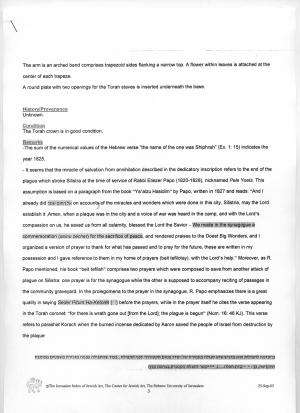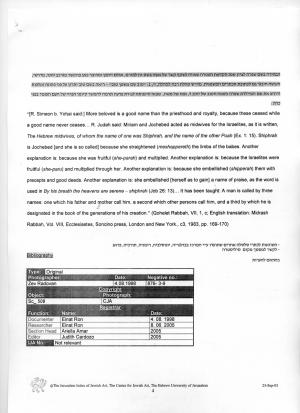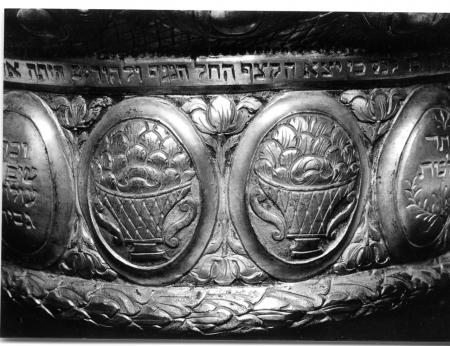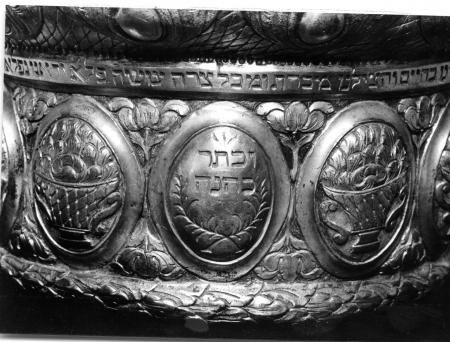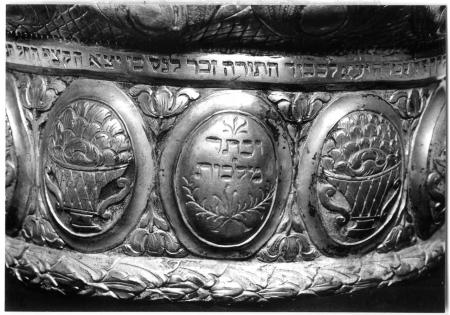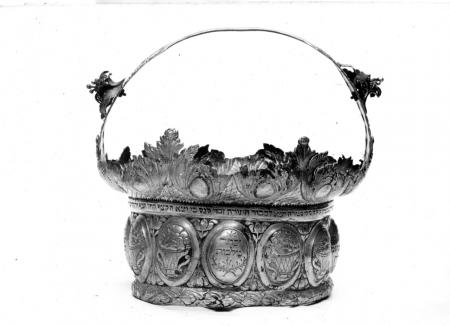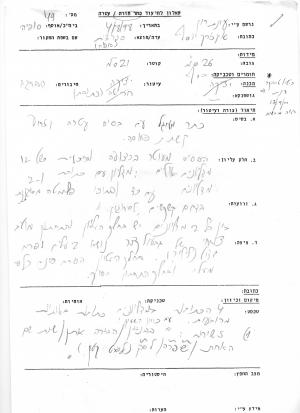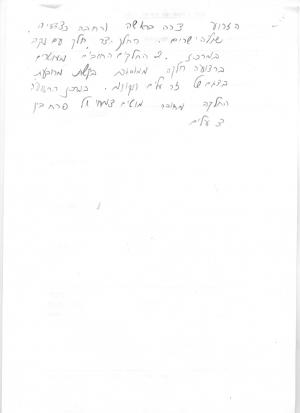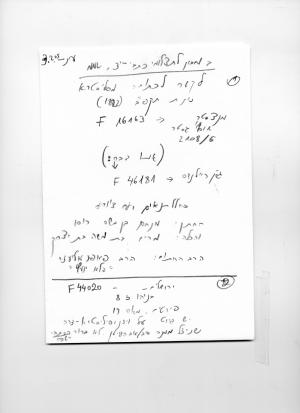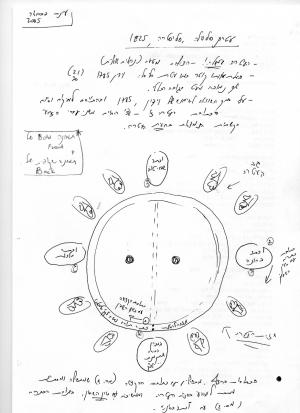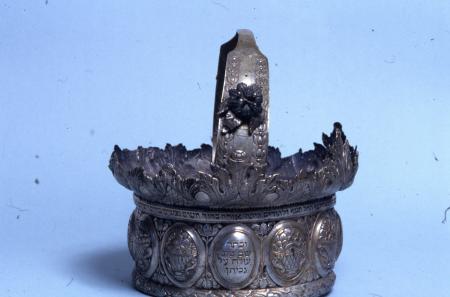Obj. ID: 11964
Sacred and Ritual Objects Keter Torah, Bulgaria?, 1825

The basket-like Torah coronet comprises a cylindrical base with an arched arm attached to its decorative vegetal rim.
The base is decorated with twelve oval medallions, each of which encloses three out of the Four Mishnaic Crowns (Avot 4:13) and a basket with palmates, alternatively. Tulips are set between the medallions. The inscription reads:
"(כתר תורה) וכתר / כהנה // וכתר / מלכות // וכתר / שם טוב / עולה על / גביהן" (אבות ד:יג).
")Crown of Torah( and the crown of Priesthood and crown of the Kingship, but the crown of a good name excels them all" (Avot 4:13).
The base is bordered by a circumferential dedicatory inscription on top and a sheathed stem below. All inscriptions are inscribed in square Hebrew letters, and are read clockwise. The dedicatory inscription starts with the Torah Crown missing in the oval medallions:
"כתר תורה נעשה לקק (קהל קדוש) סליסטרה יעא (יכוננה עליון אמן) לכבוד התורה זכר לנס 'כי יצא הקצף )מלפני ה'( החל הנגף' (במדבר יז:יא) 'ולהורים (וליהודים) היתה אורה' (אסתר ח:טז) ברוך 'השם נפשינו בחיים' (תהלים סו:ט) והצלינו מכרת ומכל צרה 'עושה פלא' (שמות טו:יא; תהילים עז:טו) יראנו נפלאות (מבוסס על מיכה ז:טו) ונזכה לראות ./. בבניין / הבירה אתן / שנת 'שם האחת / שפרה' / לפק (לפרט קטן) (שמות א:טו) ((5)585=1825)."
“Crown of Torah, has been made for the holy congregation of Silistra (Silistria), may the Sublime establish it, Amen, in honour of the Torah, in memory of the miracle, 'for there is wrath gone out (from the Lord); the plague is begun' (Num. 16:46), '(and) the Jews had light' (Esth. 8:16). Thanks the Lord 'which holdeth our souls in life', and he saved us from destruction and from all calamity, 'doest wonders' (Ex. 15:11; Ps. 77:14) will show unto us marvelous things (based on Micha 7:15), and we shall be worthy of seeing the building of the capital. I shall set the year of 'the name of the one was Shiphrah' (Ex. 1:15).” The sum of the numerical values of the marked letters indicates the year (5)585=1825; see: Remarks: no. 2.
The high rim is formed by wide acanthus leaves, each surmounted by a spherical fruit and enclosing two medallions within its lower lobes.
The arm is an arched band, decorated with a flower attached to the center of each of its trapezoidal sides.
A round plaque with two holes for the Torah staves forms the bottom of the coronet.
1. The Torah coronet was dedicated to the synagogue of Silistra, a port city situated on the southern seashore of the Danube, in northeastern Bulgaria. Its dedicatory inscription refers to the plague which struck the city when the hasidic Rabbi Eliezer Papo headed the community (1820-1828). It appears that the coronet was donated as an act of thanksgiving offering, as reported by Papo in his book of musar (ethical teaching) Ya’alzu hasidim (1827): “And I already recited El Rahum Shimkha (Lord of mercy is your Name) on accounts of the miracles and wonders which were done in this city, Silistria, may the Lord establish it, Amen, when a plague was in the city and a voice of war was heard in the camp, and with the Lord’s compassion on us, he saved us from all calamity, blessed the Lord the Saviour – We have made in the synagogue zekher le-korban todah (a commemoration of a thanksgiving offering), and rendered praises to the Doeth Great Wonders (Ps. 136:4; Yalkut Shimoni, Micha 7, no. 559), and I organized a version of a prayer to thank for what has passed and to pray for the future, these are written in my possession and I gave reference to them in Beit tefilotai (The House of My Prayers), with the Lord’s help.” (Papo, Ya’alzu hasidim, pp. 20-21 (introduction), 408-409 (Ma`amar Ha-Kavod).)
And, indeed, in his prayer book Beit tefilah Papo included two prayers to be recited in the synagogue and the Jewish graveyard, as protection from a future attack of plague on Silistra. In the synagogue prayer, he mentions the great virtues of burning incense to end a plague, as is learnt from the Bible, and cites the same verse from the Korah pericope, similar to the dedicatory inscription on the Torah coronet: (Num. 16:46). He emphasizes the great merits of reciting Seder Pitum Ha-Ketoret (order of incense tamping) after the synagogue prayer, and implores the Lord to consider the words as an appropriate replacement for the past sacrifices in the Temple, in accordance with the idea of “will we render the calves of our lips” (Hos. 14:2). See: Papo, Beit tefilah, pp. 91-94.
Notably, the coronet and Papo’s books are the sole historical evidence of the occurrence of plague in the Silistra region in those years (Panzac, La peste, pp. 164-169. On the cholera epidemic, which struck the Silistra region during the Turkish-Russian war of 1828-1829, and Papo’s sacrificial death in 1828 to save Silistra's Jews, see: Stern, Melizei esh, p. 89).
2. Apparently, the nameשפרה Shiphrah was chosen to indicate the dedication date of the coronet, since the donor saw the ending of the plague in his own community as part of the continuity of the Lord’s intervention for saving the Jewish people. This idea is proposed in a midrash to the verse “A good name is better than a precious ointment” (Ecclesias. 7:1), which also refers to the Mishnaic inscription within the medallions, depicted in our coronet. It interprets the name Shiphrah as the "good name" of Moses mother, Jochebed, who served as a midwife and through her the Israelites were fruitful (she'paru) and multiplied and saved from annihilation (Qohelet Rabbah (Vilna) 7:3; Midrash Rabbah. Vol. 8, Ecclesiastes, pp. 169-170).
sub-set tree:
The Torah crown is in good condition.
The origin of this variant is still obscure, though it is possible that the first two coronets are of a Bulgarian origin. This assumption is based on the two dedicatory inscriptions inscribed on the coronets from Vidin and Silistra. However, a stylistic comparison is still needed.
- Midrash Rabbah. Vol. 8, Ecclesiastes. London and New York: Soncino Press, 1983.
- Panzac, Daniel. La Peste dans L’Empire Ottoman, 1700-1850. Collection Turcica 5. Leuven: E. Peeters, 1985.
In French.
- Papo, Eliezer. Beit tefilah. Jerusalem: Pele Yoez Foundation, 1983. In Hebrew.
- Papo, Eliezer. Ya’alzu hasidim. 2nd ed. Jerusalem: Tushiah, 1989. In Hebrew.
- Stern, Abraham. Sefer melizei esh. New York, 1962. In Hebrew.





